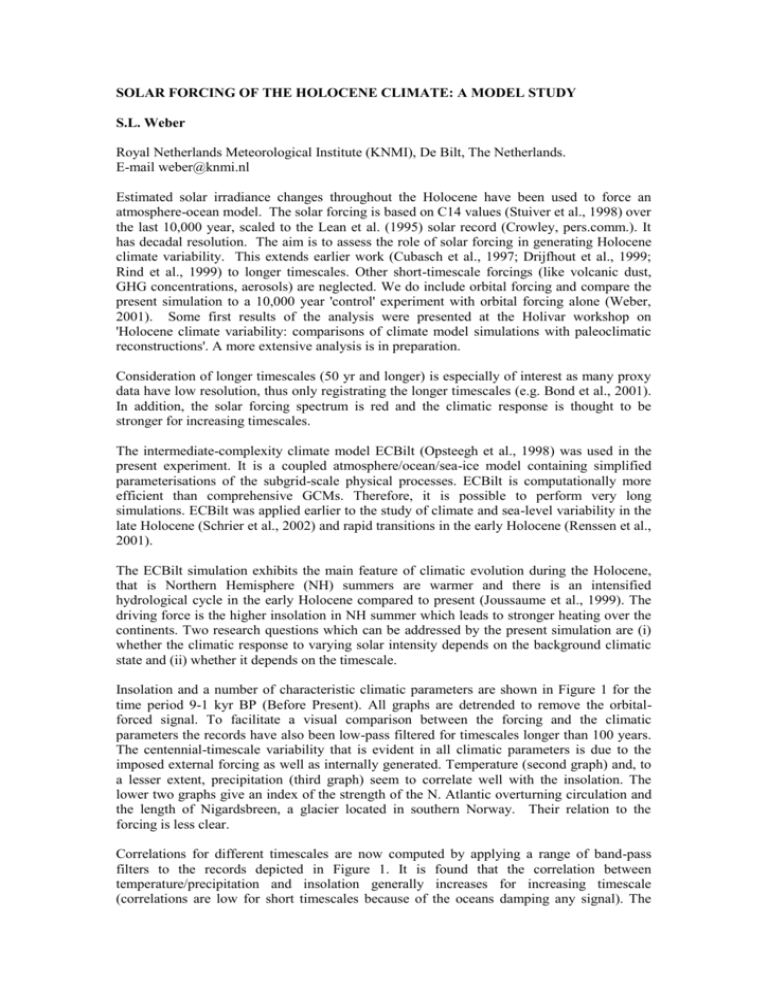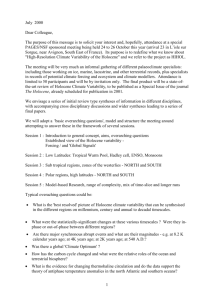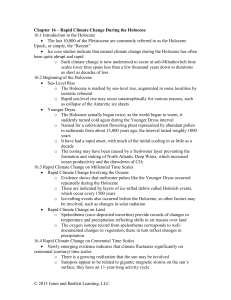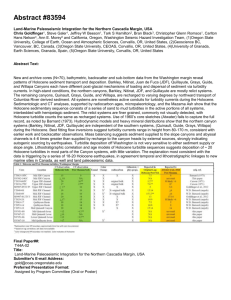SOLAR FORCING OF THE HOLOCENE CLIMATE: A MODEL STUDY
advertisement

SOLAR FORCING OF THE HOLOCENE CLIMATE: A MODEL STUDY S.L. Weber Royal Netherlands Meteorological Institute (KNMI), De Bilt, The Netherlands. E-mail weber@knmi.nl Estimated solar irradiance changes throughout the Holocene have been used to force an atmosphere-ocean model. The solar forcing is based on C14 values (Stuiver et al., 1998) over the last 10,000 year, scaled to the Lean et al. (1995) solar record (Crowley, pers.comm.). It has decadal resolution. The aim is to assess the role of solar forcing in generating Holocene climate variability. This extends earlier work (Cubasch et al., 1997; Drijfhout et al., 1999; Rind et al., 1999) to longer timescales. Other short-timescale forcings (like volcanic dust, GHG concentrations, aerosols) are neglected. We do include orbital forcing and compare the present simulation to a 10,000 year 'control' experiment with orbital forcing alone (Weber, 2001). Some first results of the analysis were presented at the Holivar workshop on 'Holocene climate variability: comparisons of climate model simulations with paleoclimatic reconstructions'. A more extensive analysis is in preparation. Consideration of longer timescales (50 yr and longer) is especially of interest as many proxy data have low resolution, thus only registrating the longer timescales (e.g. Bond et al., 2001). In addition, the solar forcing spectrum is red and the climatic response is thought to be stronger for increasing timescales. The intermediate-complexity climate model ECBilt (Opsteegh et al., 1998) was used in the present experiment. It is a coupled atmosphere/ocean/sea-ice model containing simplified parameterisations of the subgrid-scale physical processes. ECBilt is computationally more efficient than comprehensive GCMs. Therefore, it is possible to perform very long simulations. ECBilt was applied earlier to the study of climate and sea-level variability in the late Holocene (Schrier et al., 2002) and rapid transitions in the early Holocene (Renssen et al., 2001). The ECBilt simulation exhibits the main feature of climatic evolution during the Holocene, that is Northern Hemisphere (NH) summers are warmer and there is an intensified hydrological cycle in the early Holocene compared to present (Joussaume et al., 1999). The driving force is the higher insolation in NH summer which leads to stronger heating over the continents. Two research questions which can be addressed by the present simulation are (i) whether the climatic response to varying solar intensity depends on the background climatic state and (ii) whether it depends on the timescale. Insolation and a number of characteristic climatic parameters are shown in Figure 1 for the time period 9-1 kyr BP (Before Present). All graphs are detrended to remove the orbitalforced signal. To facilitate a visual comparison between the forcing and the climatic parameters the records have also been low-pass filtered for timescales longer than 100 years. The centennial-timescale variability that is evident in all climatic parameters is due to the imposed external forcing as well as internally generated. Temperature (second graph) and, to a lesser extent, precipitation (third graph) seem to correlate well with the insolation. The lower two graphs give an index of the strength of the N. Atlantic overturning circulation and the length of Nigardsbreen, a glacier located in southern Norway. Their relation to the forcing is less clear. Correlations for different timescales are now computed by applying a range of band-pass filters to the records depicted in Figure 1. It is found that the correlation between temperature/precipitation and insolation generally increases for increasing timescale (correlations are low for short timescales because of the oceans damping any signal). The maximum reached for precipitation is lower than that for temperature and it is reached at longer timescales. The lag at which optimum correlations occur is a few years. We find that the response is independent of the background climatic state. Figure 1 The length of Nigardsbreen and two other glaciers has been computed with a glacier model coupled off-line to ECBilt. The procedure is described by Weber and Oerlemans (2002). Glacier length responds to insolation mainly through the summer temperature signal. For a long response-time glacier (lags of about 70 yr) correlation increases for long timescales. However, for a short response-time glacier (lags of 30-40 yr) correlations decrease for timescales longer than about 300 yr because of negative feedbacks related to the dynamic response of the glacier. Nigardsbreen expands dramatially, thus changing its behavior over time from a short (thus fast) glacier in the early Holocene to a long (thus slow) one in the late Holocene. The present results indicate that in the case of a direct response correlations increase for increasing timescale. In the case of feedbacks strongly modifying the response correlations are maximum for a preferred range of timescales. The shape of the response function does not depend on the time period, unless system characteristics change considerably over time e.g. through strong glacier expansion. This implies that proxy data will only reflect solar forcing at 100+ timescales, but possibly not at 500+. As correlations are typically nonstationary any link may be absent in shorter records. References Bond, G., B. Kromer, J. Beer, R. Muscheler, M.N. Evans, W. Showers, S. Hoffmann, R. Lotti-Bond, I. Hajdas, G. Bonani, 2001. Persistent solar influence on North Atlantic climate during the Holocene. Science, 294, 2130-2136. Cubasch, U., R. Voss, G.C. Hegerl, J. Waskewitz, T.J. Crowley, 1997. Simulation of the influence of solar radiation variations on the global climate with an ocean-atmosphere general circulation model. Climate Dyn., 13, 757-767. Drijfhout, S.S., R.J. Haarsma, J.D. Opsteegh, and F.M. Selten, 1999. Solar-induced versus natural variability in a coupled climate model. Geophys. Res. Letters, 26, 205-208. Joussaume, S., and 33 co-authors, 1999. Monsoon changes for 6000 years ago: results of 18 simulations from PMIP, Geophys. Res. Letters, 26, 859-862. Opsteegh, J.D., R.J. Haarsma, F.M. Selten and A. Kattenberg, 1998. ECBILT: A dynamic alternative to mixed boundary conditions in ocean models, Tellus, 50A, 348-367. Renssen, H., H. Goosse, T. Fichefet and J.M. Campin, 2001. The 8.2 kyr event simulated by a global atmosphere/sea-ice/ocean model, Geophys. Res. Letters, 28, 1567-1570. Rind, D., J. Lean and R. Healy, 1999. Simulated time-dependent climate response to solar radiative forcing since 1600. J. Geophys. Res., 104, 1973-1990. Schrier, G. van der, S.L. Weber and S.S. Drijfhout, 2002. Sea level changes in the North Atlantic by solar forcing and internal variability, Climate Dyn., in press. Stuiver, M., and others, 1998. Intcal98 radiocarbon age calibration, 24,000-0 cal BP. Radiocarbon, 40, 1041-1083. Weber, S.L., 2001. The impact of orbital forcing on the climate of an intermediate-complexity coupled model. Global and Planetary Change, 30, 7-12. Weber, S.L. and J. Oerlemans, 2002. Holocene glacier variability: three case studies using an intermediate-complexity climate model. The Holocene, accepted.






